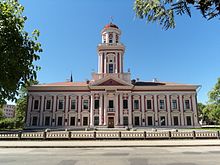
Back Jelgava Gymnasium Danish Academia Petrina German Academia Petrina Spanish Jelgava gümnaasium Estonian Academia Petrina French Jelgavos gimnazija Lithuanian Jelgavas akadēmiskā ģimnāzija Latvian/Lettish Jelgavas akadēmiskā ģimnāzija Polish Academia Petrina Russian Academia Petrina Swedish

Jelgava Gymnasium or Academia Petrina is the oldest higher educational establishment in Latvia.[1] Based on an idea by Friedrich Wilhelm von Raison, it was established in Mitau, capital of the Duchy of Courland and Semigallia, by Duke Peter von Biron in 1775. The duke wanted to attract professors like Immanuel Kant and Johan Gottfried Herder, but they refused.
After the partitions of the Polish–Lithuanian Commonwealth, Jelgava became part of the Russian Empire and the gymnasium unsuccessfully petitioned to become a university.[2] Nevertheless, it became an important cultural hub not only for Latvians, but also Lithuanians.[3] Many famous professors had lectured in Academia Petrina for example Johann Benjamin Koppe (1775), Johann August von Starck (1777–1781) and Wilhelm Gottlieb Friedrich Beitler (1775–1811).
During World War I, the school was evacuated to Taganrog in Rostov Oblast while its 42,000-volume library was burned by troops of Pavel Bermondt-Avalov.[4] During World War II, the historical school building was almost completely destroyed, therefore school was reestablished in new premises. The original building was later restored and now functions as the Ģederts Eliass Jelgava History and Art Museum.
- ^ Peck, Bryan T. (24 January 2019). Education, the Baltic States and the EU. Nova Publishers. ISBN 9781590337097. Retrieved 24 January 2019 – via Google Books.
- ^ Vihalemm, Rein (30 September 2001). Estonian Studies in the History and Philosophy of Science. Springer Science & Business Media. ISBN 9780792371892. Retrieved 24 January 2019 – via Google Books.
- ^ Sabaliunas, Leonas; Sabaliūnas, Leonas (24 January 1990). Lithuanian Social Democracy in Perspective, 1893–1914. Duke University Press. ISBN 0822310155. Retrieved 24 January 2019 – via Google Books.
- ^ Stam, David H. (24 January 2019). International Dictionary of Library Histories. Taylor & Francis. ISBN 9781579582449. Retrieved 24 January 2019 – via Google Books.